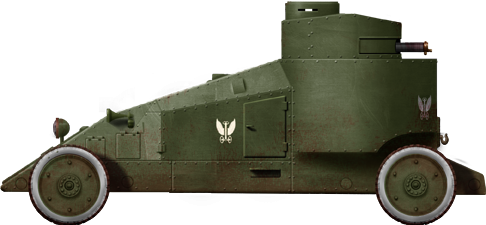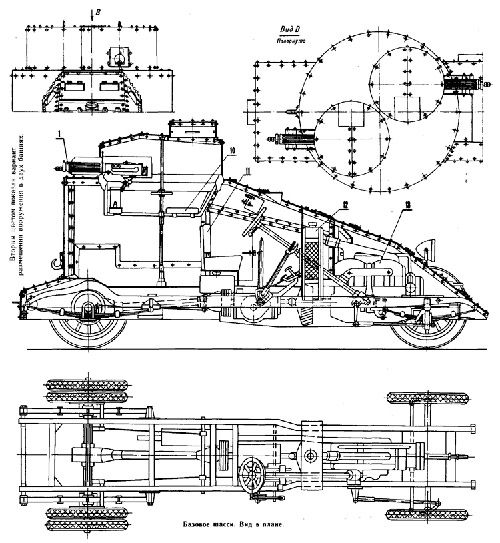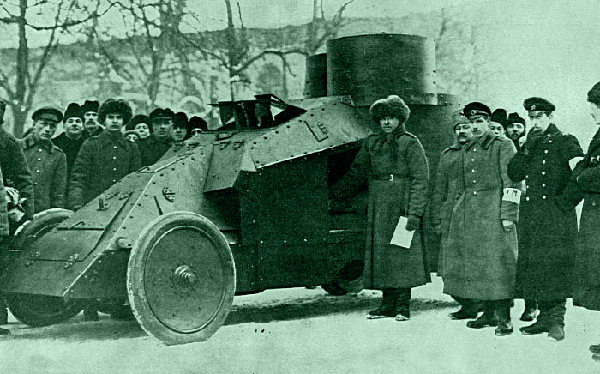Designed by Staff captain Mgebrov
Staff captain Mgebrov was a Russian officer who sought to convert a series of Renault and White chassis, available in Russia in 1915, to armored cars. He tested his ideas about sloped armor and fitted two cars with extremely well sloped armor which gave these vehicle their visual trademark. This concept was named after its creator, "Mgebrov-Renault". In a number of sources it was called "Reno" Mgebrova. It was one of the most recognizable, striking armored cars of the Russian Empire during the First World War, but not one of the most successful. It was actively tested to locate the most rational angles, increasing their bulletproof performances without excessive armor thickness. The first was completed in 1915 at the Izhorskij based on a rear-wheel (4 × 2) Renault chassisa.Design
Several sources state the chassis dimensions as 5.1 m (16.73 ft) long, 2.3 m (7.54 ft) wide, 2.32 m (7.61 ft) high, with a 4 m (13.12 ft) wheelbase. According to other visual sources, it was over 5.80 m (19 ft) long. The results of these tests were two prototypes, one equipped with a single turret, while the other had two smaller ones. 11 cars were built by the Izhorsky Works.A characteristic feature of all these machines was the large angles at which the armor plates were placed, which increased the effectiveness of the body armor. The second unusual feature was the triple turret arrangement of the original design. The two gunners fired through large portholes, covered by mobile armored flaps which allowed an increased traverse while the turrets were hand-cranked by the commander. Two Maxim model 1910 machine guns had a field of fire of about 90 degrees on the front and respective angles, but the entire structure could rotate 360°.
Because of the 3.4 ton overall weight, the basic chassis was heavily overloaded. After tests carried out at the end of April 1916, it was decided to redesign the entire vehicle. This was performed under the guidance of the Chief of Military armored automotive school captain Bazhanov, from Izhorskij, and the initial bulky three-man turret was replaced with two single turrets, placed in echelon. The extra machine-gun posts were eliminated and the armor was thinner in various angles. As a result, the weight was reduced to 2.74 tons, thus reducing the stress 2.5 times. After being converted, these vehicles could reach speeds up to 55 km/h (34 mph) on flat ground. The conversion of the whole series started eventually in 1917, just before the revolution.
Active service
The 12 vehicles were actively used by the Russian army during World War I, and later by the two opposing sides in the Civil War. Individual machines were part of the Red Army until 1930, when they were phased out. All photos from the time show the two small turrets. Few if no details about their active unit commitments are known.| Mgebrov-Renault specifications | |
| Dimensions (L-W-H) | 5.1 x 2.3 x 2.32 m (16.73x7.54x7.61 ft) |
| Total weight, battle ready | 3.4 tons (7495 lbs) |
| Crew | 3 (driver, commander, gunner) |
| Propulsion | Renault 14HP 4-cyl, air-cooled, 30bhp |
| Speed | 25 km/h (12 mph) |
| Operational range (road) | 120 km (74 mi) |
| Armament | 2 x 7.62 mm (0.3 in) Vickers machine-guns, 5000 rounds |
| Suspension | 4x2, dependent leaf spring suspension |
| Armor | 6.5 mm (0.2 in), sloped |
| Total production | 11 in 1915 |

Mgebrov-Renault in Russian service, 1915. The first model had two machine-guns in a large, bulky rotating superstructure instead of a turret.
Gallery






The Great War
 Austria-Hungary
Austria-Hungary Belgium
Belgium British Empire
British Empire France
France German Empire
German Empire Italy
Italy Russia
Russia USA
USAWW1 tanks posters

